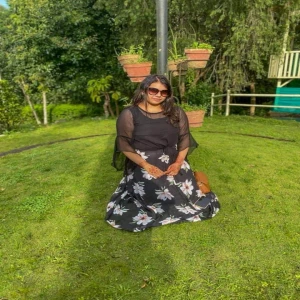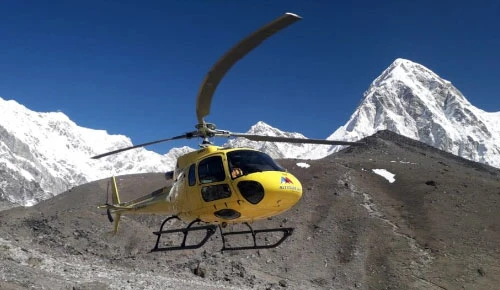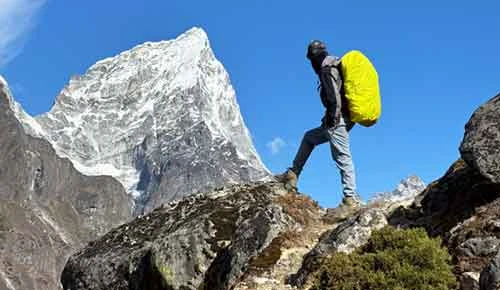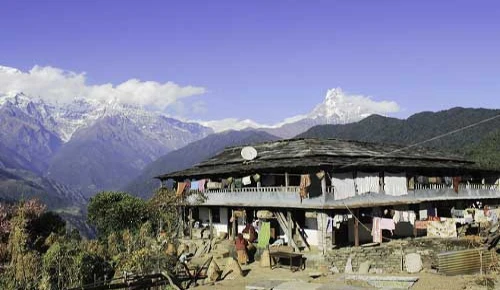Facilities During Everest Trekking Route
The Everest Region, tucked away in the majestic embrace of the Himalayas, is a tribute to the breathtaking majesty of nature.
This famous area, also known as the Khumbu Valley, is well-known for being home to Mount Everest, the world's most magnificent peak. This Himalayan retreat, which lies in northeastern Nepal, draws nature lovers, thrill-seekers, and those looking for a close encounter with an extraordinary experience of the Everest Base Camp Trek.
Trekking in the Everest Region is an experience like no other; the paths meander through steep terrain, deep forests, and lovely Sherpa communities. The trek, which brings daring trekkers to the base of the highest peak in the world, is one of the most well-known trekking routes.
Trekkers are treated to expansive views of other majestic peaks, such as Lhotse, Makalu, and Cho Oyu, throughout the route, providing a captivating background that embeds itself in the memory.
Table of Contents
Along with being a test of mental and physical toughness, the pathways leading to Base Camp serve as a showcase for the amenities and infrastructure that help trekkers on their incredible adventures.
There is a network of facilities along the rocky routes that lead to the foot of the highest mountain in the world, allowing trekkers to concentrate on the breathtaking scenery without sacrificing comfort or safety.
Along the trekking paths are teahouses, often called guesthouses or lodges, which provide tired trekkers with a place to rest, restore, and make new friends. These lodgings offer simple but necessary amenities, including hot meals, gathering places, and sleeping arrangements similar to dorms.
Trekkers endure the Himalayan mountains, cherishing the warmth of a fireplace and the companionship found in these teahouses.
The facilities along the Everest Base Camp Trek have improved recently, and a lot of teahouses now include contemporary conveniences like Wi-Fi, charging stations, and even hot showers (for a modest price).
Even if the amenities might not be lavish by city standards, they provide a much-needed break in the middle of the Himalayas. Here are some of the basic facilities that you will experience along your trail to Base Camp:
Transportation Facilities
There are just two ways to go to the Everest area. The flight in either an aircraft or a helicopter is the main accessible facility, sometimes referred to as the transportation facility. The walking route provides access to your next stops.
Flights
By flight from Kathmandu to Lukla, the Everest area can be reached most often and effectively. Because of its tiny runway and hilly terrain, Tenzing-Hillary Airport in Lukla is regarded as one of the world's most difficult airports.
However, in some cases where there are no direct flights from Kathmandu to Lukla, travelers often go to Ramechapp via local bus or Jeep and then take a flight to Lukla from Ramechhap.
 If the weather permits, several airlines provide daily flights that offer a swift and exhilarating journey into the heart of the Himalayas.
If the weather permits, several airlines provide daily flights that offer a swift and exhilarating journey into the heart of the Himalayas.
Road Transportations
Although there is no direct road access to the Everest area, you can take a car ride from Kathmandu to Salleri, where you can begin your climb.
Although it takes longer, this overland path provides a distinct viewpoint of the surroundings. There isn't as much of a road network in this hilly area, and driving is less prevalent than it is elsewhere.
Helicopter Service
When looking for a more luxurious or efficient kind of transportation, helicopter services are also offered. It is possible to charter helicopters to travel straight to locations like Everest Base Camp or Namche Bazaar. People who are short on time and mountaineers really like this choice.

We also provide helicopter services like the Everest View Helicopter Tour, Everest Base Camp with Helicopter Landing, and Everest Base Camp Trek with Helicopter Return.
Transportation on Trails
Once in the Everest area, trekking is the main mode of transportation. Trekkers follow the designated paths that link the several settlements and sites. The area's pure atmosphere is a result of the absence of motorized highways, which will allow you to fully appreciate the Himalayas' natural splendor.
For your backpacks, you will either have a local porter or use the yak for the transportation of your backpacks.
Accommodation Facilities
Trekkers can find pleasant lodging in the Everest region, which offers a unique combination of warmth and simplicity, giving them a place to stay amid the breathtaking Himalayan scenery.

The traditional teahouse, often referred to as a guesthouse or lodge, is the main kind of accommodation along the trekking routes.
Teahouses
These provide the foundation for lodging in the Everest region. Along the trekking paths are teahouses that provide minimal but necessary facilities. Common lodging options are communal restrooms and dormitory-style rooms.
With a shared eating room and a true chance to interact and exchange tales with other trekkers, the teahouse experience builds friendship.
The simplicity of the rooms stems from the area's isolation and the emphasis on giving trekkers the necessities. Here are some of the few facilities provided within the rooms of tea houses and lodges:
Twin beds
Usually, rooms contain two single beds with fresh bedding, which includes a blanket, pillow, and mattress. Bringing a sleeping bag is a smart option for extra warmth and comfort, especially in higher altitudes where the evenings may get chilly.
Luxury Lodges
Luxury Lodge has several properties in the Everest region, such as in Namche Bazaar, Phakding, and Lukla. They provide comfortable rooms, modern amenities, and excellent services.
Shared Rooms
Higher up on the trek, accommodations can get simpler, with thinner walls and communal amenities. It is occasionally necessary to share a room with other trekkers, particularly during busy teahouse seasons.
Room Insulations
Typically, tea houses lack insulation in their rooms and do not offer individual room heating. The majority of teahouses have a central gathering space with a stove or heater where trekkers can gather to exchange stories and stay warm.
Electricity and charging facilities
In the communal areas, some teahouses provide charging stations for electrical devices; however, there may be an extra fee for this service. Bringing a power bank with you can help guarantee that your electronics are fully charged for the duration of your trek.
Medical Facilities
For trekkers and mountaineers tackling difficult terrain, medical services in the Everest area are essential to their health and safety on their Trek to Everest Base Camp.
Medical facilities capable of treating minor injuries and altitude-related problems are a lifeline for trekkers in significant towns like Namche Bazaar. These facilities, operated by medical experts with training, provide basic medical treatment, oxygen therapy, and evaluation of symptoms of altitude sickness.

These medical facilities are necessary for treating the particular health issues brought on by high elevations, even if they might not be as comprehensive as those found in cities.
It is advised for trekkers to keep hydrated, be mindful of the signs of altitude sickness, and acclimate appropriately. Evacuation services, including helicopter rescues, are available to take people to lower elevations or Kathmandu medical facilities in the event of more significant medical problems.
These medical services enhance the sense of safety that comes with visiting the stunning Himalayas.
Foods
After a long day of trekking, teahouses offer substantial meals to help you regain energy. A variety of Nepali and foreign meals are offered on the menu.
A sample of the region's culinary highlights can be found in the basics, like dal bhat, which is a lentil soup served with rice. Local delicacies and comfort foods are also available.

Teahouses provide a wide range of food. Pasta, pancakes, mac and cheese, and the regional mainstays dal-bhaat, curry, and pickle or chutney momo, or flour-patched dumplings stuffed with canned tuna, vegetables, or meat, are popular.
Even when there is meat on the menu, it is best to avoid it because it is frequently pricey and not particularly fresh. The meat used in the teahouses is transported over many days by porters or mules from the lower regions. Fresh fruits are rare on the Everest Base Camp Trek because of the area's high altitude and remote location.
Toilets or washrooms
Most resorts offer Western-style restrooms at lower levels. There is a bucket of water with a mug provided so you can wash yourself instead of using toilet paper. Don't forget to bring along many rolls of toilet paper before Lukla.
The teahouse amenities similarly get progressively more basic as you ascend higher in elevation. You will have to use the shared restrooms at higher altitudes with other travelers.
You might have to settle for an Asian or squat toilet if the resort you are staying at doesn't offer a Western-style restroom. You can also find public toilets in various places along your trails.
There may be environmentally friendly composting toilets at various points along the trail, which reduces the negative effects of local waste disposal on the ecosystem. To guarantee correct usage, always remember to abide by any rules that may be placed in these spaces.
Shower Facilities
Although most lower areas have access to bucket or tap showers, trekkers find it difficult to maintain personal hygiene and sanitation due to the desert terrain's water scarcity and the chilly temperatures in some higher-altitude lodges.
Trekkers can pay for a hot or cold shower to be clean, fresh, and healthy. There are differences in the cost of the shower between tea houses and between lower and higher regions.
In nearly all tea houses and lodges, nearly 90% have hot showers. Trekkers may often get hot bucket showers or hot tap showers at a moderate cost in the lower regions of Lukla, Namche, and Phakding; however, the cost of a hot shower increases as one ascends above Tengboche, Dinhboche, and Gorakshep.
It might be difficult to acquire flowing water at higher-elevation locations like Gorakshep, so a bucket shower might be a better choice for you.
Peak trekking seasons result in a high demand for showers, making it challenging to accommodate every tourist. In high altitudes, the tap water freezes throughout the winter, leaving no way to take a shower.
You can take a cold shower with the free tap water offered on the mountain trials if you don't want to increase your spending.
Communication Facilities
Significant improvements in communication facilities have been made in the Everest region, allowing for greater connection despite the area's inaccessible mountainous landscape.
Although there aren't many ways for hikers and mountaineers to stay in touch, the area is nonetheless cut off from conventional forms of communication.
You won't have any trouble staying in touch with your loved ones while trekking in the Everest region. For a fee, teahouses along the route let you access their Wi-Fi network. However, to go through your trek, you can get a local SIM card that comes with a ton of internet access.
Since Ncell has excellent 3G network coverage across the Everest region, the firm even has a mobile tower at Base Camp so using a Ncell sim is advised. Before your trek begins, you may get a SIM card in Kathmandu.
All you need to purchase one is a passport-sized photo and a photocopy of your passport.
Conclusion
The Everest Base Camp Trek reflects the particular difficulties of the high-altitude Himalayan environment by skillfully balancing the needs of comfort with the demands of adventure.
The network of teahouses provides trekkers with a warm haven amongst the stunning scenery, complete with basic facilities and kind hospitality.
These lodging options accommodate a wide variety of tastes, from more contemporary conveniences to more traditional simplicity.
The advancement of medical facilities guarantees that trekkers' health and welfare are given priority, with clinics equipped to handle minor accidents and altitude-related problems.
With the expansion of communication capabilities, trekkers can now maintain occasional connections with the outside world.
The amenities on the trek contribute to an amazing journey, allowing adventurers to fully immerse themselves in the magic of the world's most famous mountainous landscapes, whether they are marveling at the towering peaks, enjoying the local cuisine in teahouses, or overcoming the difficulties of living at a high altitude.








